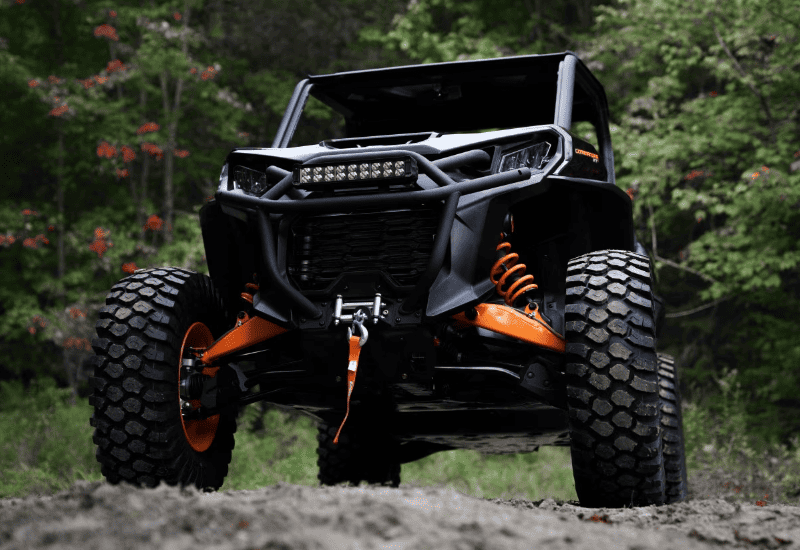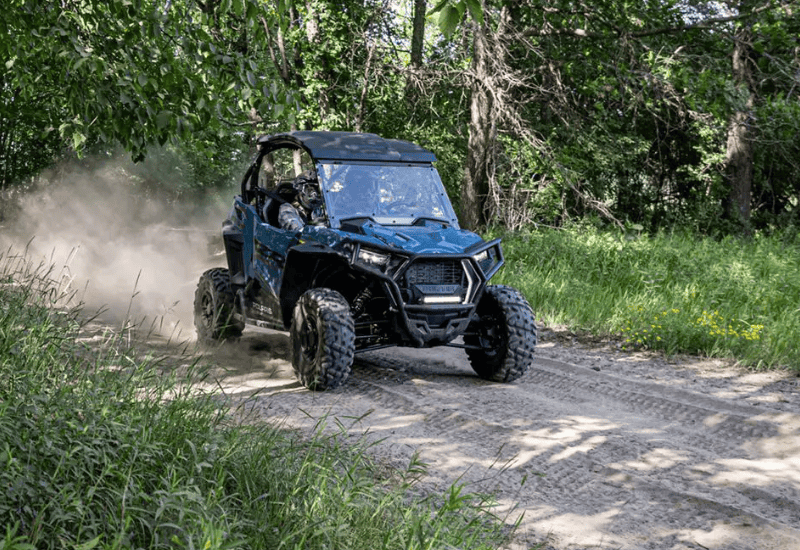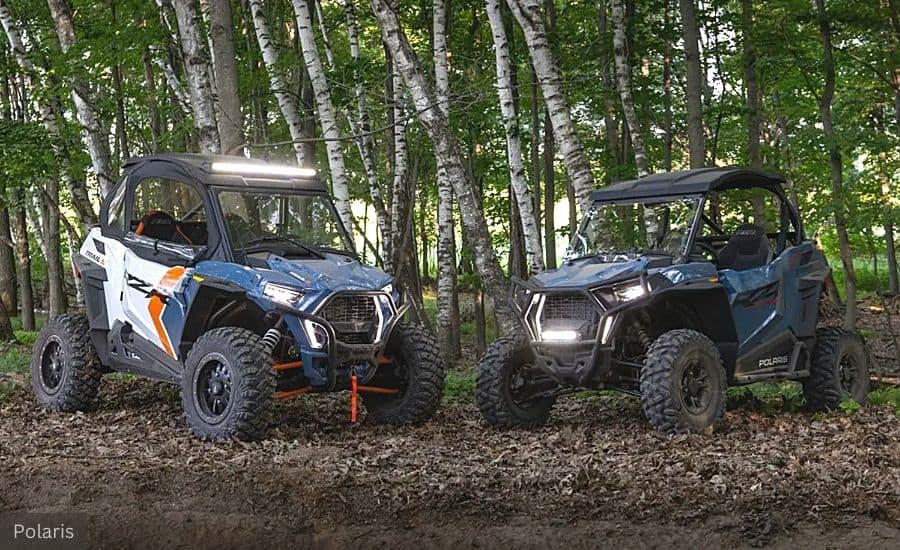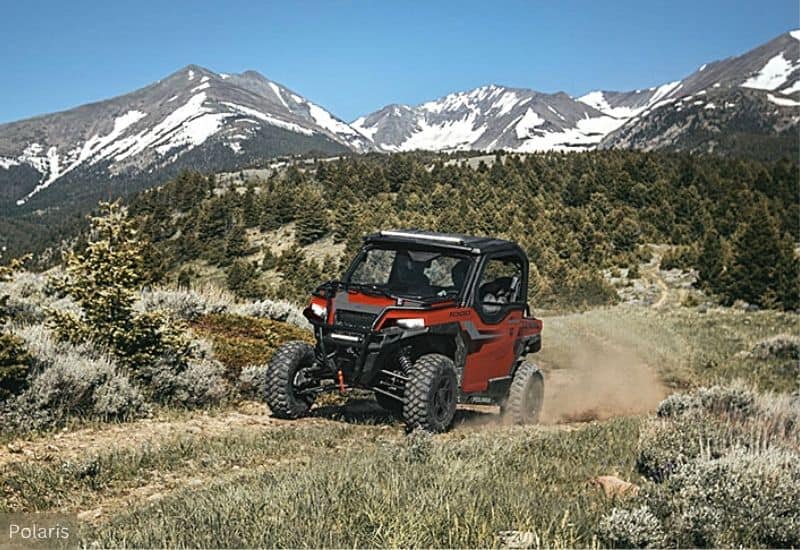UTVs, also known as side-by-sides, have surged in popularity over the last decade, thanks to their enhanced capabilities.
Because unlike ATVs or dirt bikes, they offer seating for multiple passengers and the ability to carry larger loads.
If you’ve been thinking about purchasing a utility terrain vehicle though, you’re probably wondering about their off-road capabilities.
If this sounds like you, you’re in the right place, because in the rest of this blog post, we’ll be taking a look at UTV off-road capability, design, and performance.
Key Takeaways
- UTVs are capable off-road vehicles, thanks to purpose-built chassis, long-travel suspensions, ample power, and protective features.
- UTVs excel at high-speed desert running, blasting over whoops and bumps, exploring hills and forests, and seasonal access like hunting.
- Off-road capability can vary from one model to the next depending on its design and intended use.
- UTVs are not a good fit for extreme off-roading or rock crawling.
What Makes a Good Off-Roading Vehicle?
Many factors determine a vehicle’s off-road capability, including ground clearance, suspension travel, 4WD or AWD systems, differential locks, and much more…
- Ground Clearance – Ensuring adequate clearance between the chassis and the ground is necessary to prevent bottoming out when going over obstacles or cresting hills.
- Suspension Travel – Long-wheel travel allows tires to stay in contact with various terrains, including rocky trails, steep inclines, and uneven surfaces. This is particularly beneficial in off-roading, as it ensures better traction and stability, even when navigating through challenging and unpredictable terrain.
- 4WD/AWD Systems – While 2WD vehicles rely solely on front or rear tires for propulsion, 4WD or AWD systems power all four. This distributes torque more evenly and greatly improves traction and grip.
- Locking Differentials – Locking differentials interlock a vehicle’s left and right wheels to turn in unison—a vital capability for scaling obstacles or traversing loose surfaces like mud or sand.
- Low-Range Gearing – Besides 4WD engagement, dedicated low-range gears produce tremendous amounts of low-end torque and traction.
- Skid Plates & Protective Accessories – Venturing off-road means debris gets flung by tires and the occasional rock strikes underneath. To prevent this, thick steel or aluminum skid plates can be added to shield the undercarriage.
UTV Design & Capability for Off-Roading

UTVs or side-by-sides were designed from the ground up for maximum performance, customization, occupant comfort, and safety.
To gain a better understanding of how UTVs excel at all of these things, plus much more though, we need to take a closer look at their components.
Chassis & Frame
Often built using a monocoque chassis with steel or aluminum unibody construction, UTV frames provide lightweight strength and flexibility for suspension components.
In addition, they utilize a center frame layout, which positions occupants within the frame itself surrounded by sturdy bars, for added safety.
Independent Suspension
Utility terrain vehicles typically offer independent suspensions, which provide greater wheel travel, more precise handling, and better shock damping.
This suspension system allows each wheel to move independently, which leads to improved handling and traction.
And as a bonus this also reduces the transfer of motion to the chassis, resulting in a smoother ride for passengers.
Approach, Breakover, & Departure Angles
UTVs generally offer excellent approach (front), breakover (middle), and departure (rear) angles, thanks to their minimal front and rear overhang and excellent ground clearance.
These features enable them to navigate challenging terrains and steep inclines with ease.
In addition, the superior ground clearance minimizes the risk of underbody damage, while the favorable approach and departure angles allow for smoother transitions over obstacles.
Generous Ground Clearance
UTVs traditionally lagged behind other types of off-road vehicles in ground clearance, however, thanks to longer-travel suspensions, body lifts, and larger wheels this is less of an issue on modern side-by-sides.
Aggressive Off-Road Tires & Wheels
Aggressive off-road tires and wheels are one of the defining characteristics of utility terrain vehicles.
These robust tires are designed with deep, aggressive tread patterns that grip the earth, allowing UTVs to traverse muddy ruts, sandy dunes, and rocky inclines with ease.
In addition, the substantial width and diameter of the tires provide a large contact area, distributing the vehicle’s weight more evenly and preventing it from sinking into softer ground.
Manufacturers typically construct the wheels from durable materials like heavy-duty aluminum or steel, engineering them to withstand the punishing conditions of off-road travel.
Plus, some of the more extreme UTVs even offer beadlock designs that clamp the tire onto the wheel, securing it in place even when air pressure is low for better traction.
UTV Power & Performance

UTVs tend to have larger, more powerful engines compared to other types of off-road vehicles, like ATVs and dirt bikes.
They commonly have 1000cc engines or larger, which is particularly useful in hauling heavy loads or conquering tough terrain.
The larger displacement engines also provide the necessary power for a variety of utility tasks, such as pulling trailers or plowing snow, making UTVs versatile vehicles not just for recreation but also for agriculture and landscaping.
Ample Low-End & High-End Torque
While horsepower grabs headlines, torque gets you there – especially when hauling multiple people up steep grades or through twisted trails.
And the good news is that UTVs have ample low-end and high-end torque.
Abundant Horsepower
Engineers design utility terrain vehicles to tackle demanding environments and heavy loads, so they require lots of power.
Because of this, UTVs typically have powerful engines that produce between 100 and 200 horsepower, which is a lot, considering how small and lightweight they are.
This power enables them to navigate rugged terrain with ease, climb steep inclines, and maintain high speeds even when laden with gear or passengers.
Amazing Power-to-Weight Ratio
It’s not all about sheer power though, as UTVs also offer amazing power-to-weight ratios that make them agile and responsive in a variety of conditions.
This balance between power and lightweight design allows for impressive acceleration and nimble handling, which is crucial when navigating through tight trails.
The power-to-weight ratio also contributes to the UTV’s ability to traverse soft or difficult terrains, like mud or sand where heavier vehicles might sink or become bogged down.
Off-Road Capability Can Vary Between Models
While all UTVs and side-by-sides offer a good amount of off-road capability, this can vary from one model to the next, depending on its overall design and intended use.
So we’ve broken down the main UTV classes below.
When we talk about UTVs, we’re generally looking at three primary categories, including utility-focused, sport-oriented, and those built for extreme off-roading.
UTV Classes
- Utility UTVs: These are the workhorses of the UTV world. Designed primarily for work-related tasks, they’re often used in farming and hunting. Utility UTVs are characterized by their:
- Larger Cargo Space: They often have a sizable bed for hauling gear or supplies.
- Lower Speed but High Torque: Manufacturers build them not for speed, but for power and the ability to navigate challenging terrains while carrying loads.
- Durable Construction: Their build is robust to withstand tough conditions, and they often come equipped with winches and tow hooks.
- Less Emphasis on Suspension: While they have decent suspension systems, the focus is more on load-bearing and durability rather than high-speed performance.
- Sport UTVs: Now, these are your adrenaline-pumping, high-speed machines. Designed for recreational use, sport UTVs are all about speed, agility, and performance. Here’s what sets them apart:
- High-Performance Engines: They’re equipped with powerful engines to deliver high speeds and quick acceleration.
- Advanced Suspension Systems: To handle high-speed maneuvers and jumps, sport UTVs have sophisticated suspension systems.
- Lighter and More Agile: Their construction is nimble, allowing for sharp turns and quick movements.
- Stylish Designs: Sport UTVs often have more eye-catching and sleek designs.
- Extreme Off-Road UTVs: These UTVs are a breed of their own, engineered for the most challenging terrains and conditions.
- Reinforced Structures: They’re built with robust frames and components to withstand the rigors of extreme off-roading.
- High Ground Clearance and Aggressive Tires: To navigate over rocks, logs, and rough terrain, these UTVs have significant ground clearance and tires designed for maximum traction.
- Specialized Suspension Systems: Their suspension is designed not just for speed, but for absorbing significant impacts and providing stability on very uneven surfaces.
- Additional Off-Road Features: Things like snorkels for water crossings, skid plates to protect the undercarriage, and enhanced 4×4 capabilities are common.
UTV Limitations
Even the most capable UTVs, regardless of their category and design, have their limitations.
Because of this, it’s essential to understand these constraints to ensure both the safety of the rider and the longevity of the vehicle.
Let’s break down some of these limitations:
- Terrain Challenges: While UTVs are designed for off-road use, certain terrains can still pose significant challenges. For instance, extremely rocky or steep areas might be too much for a utility UTV. Similarly, deep mud or water can pose a problem for sport UTVs if they lack appropriate tires or waterproofing.
- Load Capacity: Utility UTVs can haul, but they have a limit to the weight they can safely carry or tow. Overloading a UTV not only reduces its performance but can also lead to mechanical failures or accidents.
- Speed Limits: Sport UTVs are speedy, but they’re not race cars. Pushing them beyond their designed speed limits, especially on uneven terrain, can result in loss of control and serious accidents.
- Mechanical Wear and Tear: UTVs, especially those used in extreme off-roading, are subject to a lot of wear and tear. Regular maintenance is crucial, but even with the best care, parts will wear out and need replacement. It’s important to recognize that these vehicles are tough, but not indestructible.
- Safety Considerations: No matter how well-designed a UTV is, it can’t compensate for reckless driving. The laws of physics still apply, and things like sharp turns at high speeds or climbing excessively steep slopes can lead to rollovers and accidents.
Conclusion

Modern UTVs deliver impressive off-road capability thanks to their purpose-built chassis, heavy-duty suspensions, powerful engines, and protective features.
These robust machines have revolutionized off-roading, offering off-road enthusiasts a blend of performance, utility, and thrill that was hard to imagine just a couple of decades ago.
Whether you’re hauling heavy loads across a farm, tearing up the dunes for fun, or conquering treacherous trails, there’s a UTV built for the task.
However, as we’ve discussed, it’s crucial to remember that every UTV has its limits.
Understanding and respecting these limits not only ensures your safety but also helps in maintaining the integrity and longevity of these off-road machines.
Recent Posts
Is Can-Am Better Than Polaris? This question has been debated for years, sparking intense debates in off-road communities and showrooms. As two titans in the world of ATVs and UTVs, Can-Am and...
Whether you're an adult looking for a new adventure or introducing your kids to the sport, finding the best beginner dirt bike is crucial to kick-start your off-road journey on the right...

